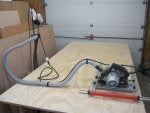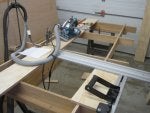My next "Big" shop project is a bench for cutting panels to size, using my EZbridge and track Wooden Clamps,Wood clamps,Panel saw, Clamps, Saw, Circular saw, Track saw,Routers. I have been intrigued with the whole Festool/MFT concept of using the dog holes to square up parts on the top - using the dogs, it should be easy to set both the track and the fence square to each other, as demonstrated on various Festool videos where they use the dog holes to square the track and a fence before cutting parts to size. I have looked at using two MFT tops https://www.amazon.com/Festool-495544-Replacement-Perforated-Multifunction/dp/B003KN3VZK side-by-side to give me the size I need.
Then I see that Lee Valley is now selling the "kit" for laying out and drilling these holes, accurately, in your top of choice.
Parf Guide Drilling System - Lee Valley Tools
The cost seemed a little high until I compared it with the cost of two of the replacement MFT tops ($169 versus $270), and I'd have the advantage of getting the top exactly the size I want. This project is getting close to the top of my list so I'm going to look a little closer at the system before making a decision, maybe watch the video a couple more times.
Anyone using the MFT tops and have any comments, likes/dislikes of the system?
Then I see that Lee Valley is now selling the "kit" for laying out and drilling these holes, accurately, in your top of choice.
Parf Guide Drilling System - Lee Valley Tools
The cost seemed a little high until I compared it with the cost of two of the replacement MFT tops ($169 versus $270), and I'd have the advantage of getting the top exactly the size I want. This project is getting close to the top of my list so I'm going to look a little closer at the system before making a decision, maybe watch the video a couple more times.
Anyone using the MFT tops and have any comments, likes/dislikes of the system?













